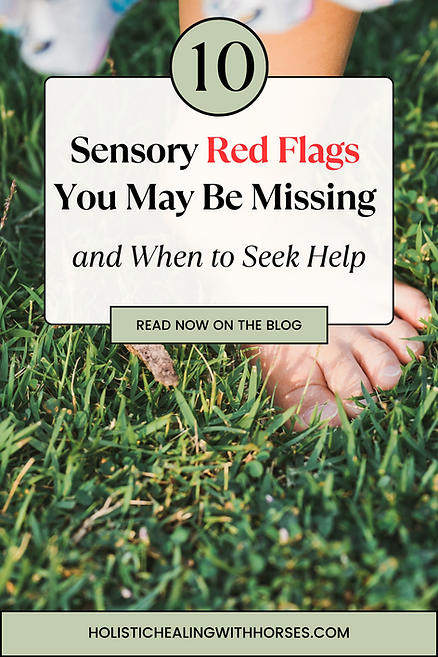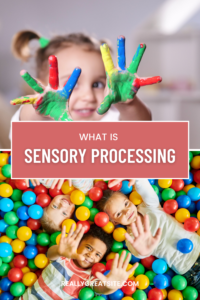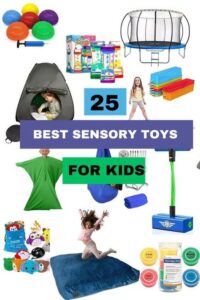
10 Sensory Red Flags You May Be Missing and When to Seek Help
Learn the critical role sensory processing plays in childhood development and how to recognize potential sensory red flags for sensory processing disorders.

Hi! My name is Marra and I’m a mama and a pediatric occupational therapist who has years of experience working with children with sensory processing difficulties and helping their parents navigate the ups and downs of child development.
I loved being a support person for parents learning about autism, sensory processing, and their child’s individual needs.
Sensory Processing and Sensory Processing Disorders have gained more attention in recent years. A big part of this is due to the steadily increasing number of children struggling with sensory processing disorders or sensory processing challenges.
Sensory processing and sensory red flags is not usually as straightforward as it seems or super easy to understand. Sensory processing is really important, and everyone processes sensory information constantly.
Sensory processing is our brain’s ability to take in sensory information through our 8 senses, understand and make sense of all of it, and then decide how to respond. Every human being does it all of the time.
I’m not sure if you caught that, but yes, I did say EIGHT senses before. I know we were all led to believe that we have 5 sensory systems, including what we see, hear, taste, touch, and smell, but we actually have an additional 3 sensory systems that many people aren’t as familiar with, including vestibular, proprioception, and interoception.
Our vestibular sensory system is our sense of movement and balance. Proprioception is our sense of deep pressure and body awareness. Interoception is our sense of how our bodies are feeling. To learn more about our 8 sensory systems, check out What You Need to Know about Sensory Processing.

Occupational therapists (OT) are healthcare professionals who specialize in sensory processing. I have my doctorate in occupational therapy and have spent years working with children with sensory processing challenges, and I absolutely love it!
WHY IT’S EASY TO MISS SENSORY RED FLAGS
What to look for when assessing a child’s sensory needs is not straightforward, and sensory red flags are easily overlooked. Most pediatricians don’t even pick up on them.
I hope this changes as public awareness and acceptance of sensory processing challenges grow. If you have questions or concerns with your child’s sensory processing needs, it’s best to talk to an occupational therapist.
It’s important to understand that similarly to how sensory processing occurs in everyone, we each have unique sensory needs. Some of us get car sick, while others love roller-coasters.
My mom always tells us how when we were kids and on family vacations, I would love to roll my whole body in the sand while my brother didn’t want any sand on his clean towel. We are all unique, and our bodies need and dislike different sensory experiences.

WHEN SHOULD I BE CONCERNED?
If we all have different sensory needs, when should I be concerned? Well, occupational therapists use a holistic lens when assessing a child’s sensory needs. An OT wants to know how an individual’s sensory processing needs impact participation in their occupations or meaningful activities.
If your child has a few sensory quirks that don’t negatively impact their lives, that’s pretty typical. You’ll want to consider if their sensory red flags impacted their ability to meet developmental milestones,
Are their sensory needs causing significant stress in your child’s life or your home environment? Are your child’s sensory needs preventing your child from participating in certain activities in your home or the community that you would like to do? These are some of the questions an OT would ask.
If you have concerns about your child’s sensory needs, talking with an OT can be really helpful. I’ve listed 10 sensory red flags below for you to take a look at. This is not an exhaustive list, and it doesn’t replace an OT evaluation. However, if your child has experienced or is experiencing several of these red flags, it might be helpful to look into it further and talk with an OT.
10 sensory red flags to look for
not crawling
Crawling is, in my professional opinion, one of the most critical developmental skills an infant accomplishes in their first year of life.
It is so important and so beneficial. Research has shown a link between infants who spend a significant time crawling and later academic success. I think crawling is so important I would have the older kids I saw in therapy crawl as part of their treatment.
Now don’t worry if your child didn’t crawl. Remember, these red flags don’t stand alone, but If you notice a few other red flags, they may predict some sensory processing challenges.
HYPERSENSITIVITY
Hypersensitivity occurs when an individual is very sensitive to certain sensory input. It’s really important to understand this is not a choice of “I don’t want to brush my teeth” or “I don’t want to eat vegetables.”
Hypersensitivity is unconscious, and it’s our body’s way of saying that doesn’t feel good, or I don’t feel safe. Hypersensitivity in children needs to be respected at all times, and forcing a child to participate in an activity that they are extremely sensitive to will only make it worse.
Some everyday things children are hypersensitive to are textures, clothing, foods, lights, sounds, busy environments, and movement.

HYPOSENSITITY
Hyposensitivity is the opposite of hypersensitivity. This is when a child needs a lot of sensory information in order to respond. Some examples of this are not noticing when someone walks into the room, a noise, or someone calling their name.
Other examples include a very high pain tolerance, decreased body awareness, and personal space, overstuffing their mouth when eating, and aggressive behavior that lacks aggressive intent.
TOe WALKING
Toe walking can be a sign of sensory processing difficulties. Kids toe walk for various reasons, so it’s always a good idea to talk with an OT.
Some sensory-related reasons a child might toe walk are because they are sensitive on their feet or seek out more proprioceptive input by walking on their feet so that there is more pressure on their feet and ankle joints.

HIGH PAIN TOLERANCE
This can be because a child has hyposensitivity but not necessarily. If your child seems to have a really high pain tolerance, this could be a red flag for sensory processing difficulties.
PICKY EATING
Picky eating can be a sensory red flag, especially if it is consistent (not a phase) and there is a certain flavor or texture they avoid altogether, or they have less than 10 foods they will eat on a regular basis. If they had difficulties feeding as an infant, this might also be due to sensory challenges.
UNRESPONSIVE
Unresponsiveness is related to hyposensitivity. This is when your child doesn’t respond to their name or your voice when you call them. Decreased eye contact can also be a red flag.
DECREASED ATTENTION
Is your child constantly on the move and struggles to sit still for more than a couple of minutes? This can be due to sensory needs as well and out of their control.
All kids need to move their bodies, but if your child consistently has difficulty attending to seated activities, this could be due to a sensory processing challenge.
AVERSION TO BEING TOUCHED
When your child was an infant, did they want you to hold them all the time? That’s a really good thing and a typical sensory need of infants. The need to be touched and held. If your child did not like to be held as a baby and doesn’t like to be touched now, that could mean they have some sensory processing challenges.
WHEN TO SEEK HELP?
Whether a child has sensory processing challenges is never a simple question and requires a professional such as an OT to do a comprehensive evaluation. If you have concerns that your child has sensory needs, you can schedule a time to talk with an OT and see if they would recommend an evaluation.
Remember, all the OT would do is make recommendations, and it’s up to you to decide what is best for your child and family. If your child has sensory needs, OT can be a helpful tool for your child, and sensory therapy, it is all play-based therapy.

